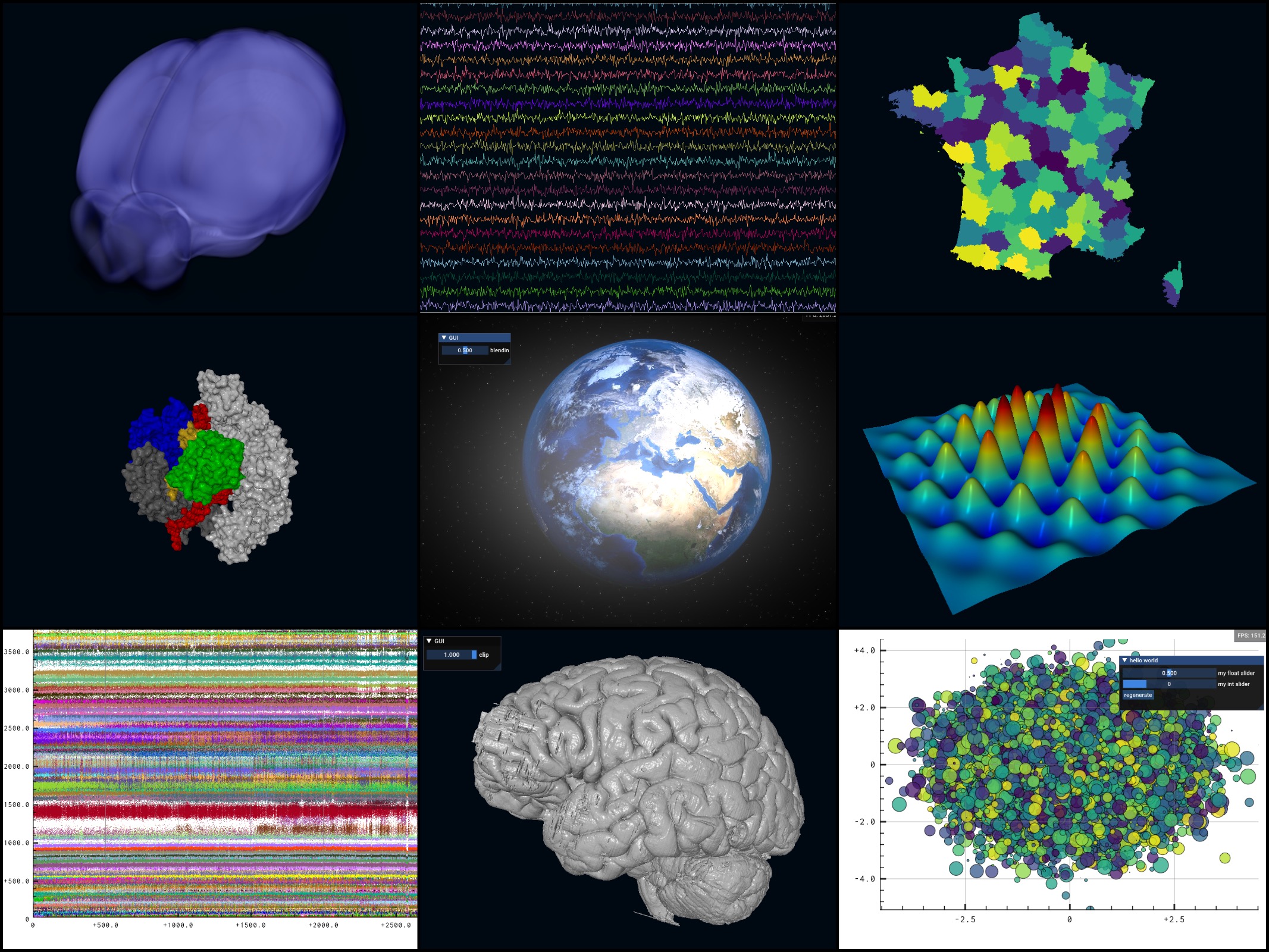https://github.com/datoviz/datoviz
⚡ Datoviz: high-performance GPU scientific data visualization C/C++/Python library
https://github.com/datoviz/datoviz
c cpp data-visualization data-viz gpu graphics python rendering scientific-computing scientific-visualization visualization vulkan
Last synced: 8 months ago
JSON representation
⚡ Datoviz: high-performance GPU scientific data visualization C/C++/Python library
- Host: GitHub
- URL: https://github.com/datoviz/datoviz
- Owner: datoviz
- License: mit
- Created: 2020-07-21T20:48:09.000Z (over 5 years ago)
- Default Branch: main
- Last Pushed: 2024-11-18T17:10:45.000Z (11 months ago)
- Last Synced: 2024-11-19T09:09:02.569Z (11 months ago)
- Topics: c, cpp, data-visualization, data-viz, gpu, graphics, python, rendering, scientific-computing, scientific-visualization, visualization, vulkan
- Language: C
- Homepage: https://datoviz.org
- Size: 30.8 MB
- Stars: 596
- Watchers: 23
- Forks: 25
- Open Issues: 24
-
Metadata Files:
- Readme: README.md
- Changelog: CHANGELOG.md
- Contributing: CONTRIBUTING.md
- License: LICENSE
- Citation: CITATION.cff
Awesome Lists containing this project
- awesome-eit - Datoviz
README
# Datoviz: GPU interactive scientific data visualization with Vulkan
**Datoviz** is an open-source **high-performance interactive scientific data visualization library** leveraging the graphics processing unit (**GPU**) for speed, visual quality, and scalability. It supports both 2D and 3D rendering, as well as minimal graphical user interfaces (using the [Dear ImGUI library](https://github.com/ocornut/imgui)).
**Written in C/C++**, Datoviz has been designed from the ground up for **performance**. It provides native **Python bindings** (based on Cython). Bindings to other languages could be developed thanks to community efforts (Julia, R, MATLAB, Rust, C#, and so on). Datoviz uses the [**Vulkan graphics API**](https://www.khronos.org/vulkan/) created by the Khronos consortium, successor of OpenGL. Supporting other modern graphics API, such as WebGPU, would constitute interesting developments.
Datoviz is currently being developed mostly by [Cyrille Rossant](https://cyrille.rossant.net) at the [International Brain Laboratory](http://internationalbrainlab.org/), a consortium of neuroscience research labs around the world.
> **Note**: Although its inception and development occurred over a long history spanning more than a decade, Datoviz is still an **early stage library** that would now benefit from increased community feedback. The current [**v0.1x version**](https://datoviz.org/) was released in 2021 and is available in this main branch. The upcoming **v0.2x version** is now available (in a [separate git branch](https://github.com/datoviz/datoviz/tree/v0.2x)) to audacious users for early testing and community feedback.
## Screenshots

*Credits: mouse brain volume: [Allen SDK](https://alleninstitute.github.io/AllenSDK/). France: [Natural Earth](https://www.naturalearthdata.com/). Molecule: [Crystal structure of S. pyogenes Cas9 from PDB](https://www.rcsb.org/structure/4cmp) (thanks to Eric for conversion to OBJ mesh). Earth: [Pixabay](https://pixabay.com/fr/illustrations/terre-planet-monde-globe-espace-1617121/). Raster plot: IBL. 3D human brain: [Anneke Alkemade et al. 2020](https://www.frontiersin.org/articles/10.3389/fnana.2020.536838/full), thanks to Pierre-Louis Bazin and Julia Huntenburg.*
## Code example
```python
import numpy as np
from datoviz import canvas, run, colormap
panel = canvas(show_fps=True).scene().panel()
visual = panel.visual('marker')
N = 10_000
pos = np.random.randn(N, 3)
ms = np.random.uniform(low=2, high=35, size=N)
color = colormap(np.random.rand(N), cmap='viridis')
visual.data('pos', pos)
visual.data('ms', ms)
visual.data('color', color)
run()
```
## Documentation
The documentation is divided into:
* **[Installation](https://datoviz.org/tutorials/install/)**: install guide,
* **[Quick start tutorial](https://datoviz.org/tutorials/quickstart)** with Python,
* **[Examples](https://datoviz.org/examples/)**: gallery of Python examples,
* **[How to guides](https://datoviz.org/howto/)**: advanced topics explaining how to use the C API, how to create custom visuals...
* **[Reference](https://datoviz.org/reference/)**: comprehensive list of included colormaps, visuals, and graphics pipelines,
* **[Discussions](https://datoviz.org/discussions/)**: high-level discussions, Vulkan crash course...
* **[C API reference](https://datoviz.org/api/)**,
## Preliminary performance results
* scatter plot with 10M points: **250 FPS** (`point` visual)
* high-resolution 3D mesh with 10M triangles and 5M vertices: **400 FPS**
* 1000 signals with 30K points each (30M vertices): **200 FPS**
*GPU: 2019 NVIDIA GeForce RTX 2070 SUPER. Window size: 1024x768.*
## Features
### Current features
* **High-quality antialiased 2D visuals**: markers, paths, lines (contributions by Nicolas P. Rougier, code from [Glumpy](https://glumpy.github.io/))
* **3D visuals**: meshes
* **Mixing 2D and 3D** plots seamlessly in the same window
* **~150 colormaps** included (from matplotlib, colorcet, MATLAB)
* **High-level interactivity**: pan & zoom, mouse arcball, first-person cameras
* **Axes**: ticks, grids, labels
* **Subplots** organized in a grid layout
* **GUIs** integrated via the **Dear ImGUI** C++ library (Qt or other backends not required)
* **Custom visuals**, with custom shaders and/or custom data transformations
### Experimental/work-in-progress features
* Multiple canvases
* Builtin creencasts and video recording with ffmpeg (optional dependency)
* Offscreen rendering and CPU emulation via swiftshader
* Mouse picking
* IPython event-loop integration
* DPI-aware canvases
* Continuous integration and continuous building
* Panel linking, shared axes
### Longer-term features
* More visuals: arrows, triangulations, planar straight-line graphs (PSLG), histograms, areas, graphs, fake 3D spheres...
* Further data transformations: logarithmic, polar, basic Earth coordinate systems for geographical data
* Fixed aspect ratio
* Colorbars
* 3D axes
* Deep zooming
* CUDA-Vulkan interoperability example
* Better support of multiple GPUs
* Qt integration
* Bindings in other languages (Julia, R, MATLAB, Rust...)
* Automated benchmarkes
* Distributed architecture (integration in the web browser, Jupyter...)
## History and roadmap
* late 2019: first experiments with using Vulkan for scientific visualization
* 2020: multiple cycles of prototyping and refactoring
* **17 Feb 2021**: first public experimental release (manual compilation required)
* **31 May 2021**: first experimental release `v0.1.0-alpha.0` with precompiled pip wheels for Linux, Windows, macOS
* **20 Oct 2021**: new experimental release `v0.1.0-alpha.1` with bug fixes and minor improvements
* **early 2022?**: final `v0.1.0` release
* **late 2022?**: redesigned internal architecture for multithreading and distributed environments (still a work-in-progress)
## Credits and related projects
Datoviz borrows heavily ideas and code from other projects.
### VisPy
[**VisPy**](https://vispy.org/) is a Python scientific visualization library created in 2013 by Luke Campagnola (developer of [**pyqtgraph**](http://www.pyqtgraph.org/)), Almar Klein (developer of [**visvis**](https://github.com/almarklein/visvis)), Nicolas Rougier (developer of [**glumpy**](https://glumpy.github.io/)), and myself (Cyrille Rossant, developer of **galry**). We joined forces to create a single library unifying all of our approaches. There is today a community of users and projects based on VisPy ([napari](https://napari.org/)). David Hoese and some of the original VisPy developers are currently maintaining the library. The current version of VisPy suffers from the limitations of OpenGL, a 30-year-old technology.
In 2020, VisPy received a 1-year [funding from the **Chan Zuckerberg Initiative (CZI)**](https://chanzuckerberg.com/eoss/proposals/rebuilding-the-community-behind-vispys-fast-interactive-visualizations/) to improve the documentation and knowledge base.
In 2021, VisPy received another [CZI grant](https://chanzuckerberg.com/eoss/proposals/vispy-2-0-next-generation-interactive-scientific-visualization-in-python/) for building VisPy 2.0, a completely redesigned library leveraging newer GPU technology such as Vulkan and WebGPU. The current strategy is to rebuild VisPy on top of Datoviz, pygfx (a WebGPU-based library developed by Almar Klein), and other backends.
### Glumpy
Glumpy, developed by Nicolas Rougier, provides [efficient implementations of high-quality 2D visuals on the GPU](https://www.labri.fr/perso/nrougier/python-opengl/), using algorithms from the antigrain geometry library. The GPU code of most 2D visuals in Datoviz comes directly from Glumpy.
### Dependencies and algorithms
* [LunarG Vulkan SDK](https://www.lunarg.com/vulkan-sdk/) **(mandatory)**
* [GLFW](https://www.glfw.org/) **(mandatory)** (support for alternative window backends will be considered)
* [ffmpeg](https://ffmpeg.org/) (optional), for making live screencasts
* [libpng](http://www.libpng.org/pub/png/libpng.html) (optional), for making PNG screenshots
* [glslang](https://github.com/KhronosGroup/glslang) (optional), for compiling GLSL shaders to SPIR-V on the fly
* [earcut](https://github.com/mapbox/earcut) (included), developed by Mapbox, for polygon triangulations
* [triangle](https://www.cs.cmu.edu/~quake/triangle.html) (included), developed by Jonathan Richard Shewchuk, for Delaunay triangulations
* [extended Wilkinson algorithm](http://vis.stanford.edu/papers/tick-labels) (included) for tick placement
* [Dear ImGUI](https://github.com/ocornut/imgui) (included)
* [antigrain geometry](https://en.wikipedia.org/wiki/Anti-Grain_Geometry) (GLSL implementation included)
* [msdfgen](https://github.com/Chlumsky/msdfgen): multi-channel signed distance field (to do: bundle as submodule?)
* [freetype](https://www.freetype.org/) (optional)
### Related projects
* [mayavi](https://docs.enthought.com/mayavi/mayavi/)
* [VTK](https://vtk.org/)
* [napari](https://napari.org/)
* [vedo](https://github.com/marcomusy/vedo)
* [ipygany](https://ipygany.readthedocs.io/en/latest/)
* [ipyvolume](https://github.com/maartenbreddels/ipyvolume)
* [Makie.jl](http://makie.juliaplots.org/stable/)
## Funding
Datoviz is being developed by [Cyrille Rossant](https://cyrille.rossant.net/) at the [International Brain Laboratory](https://www.internationalbrainlab.com/), with funding from the Simons Foundation, the Flatiron Institute, the Wellcome Trust, INCF. The logo was graciously created by [Chiara Zini](https://www.linkedin.com/in/czini/).




Glossary:
*[Vulkan]: Low-level graphics API created by Khronos, and successor of OpenGL
*[shaders]: code written in GLSL and executed on the GPU to customize the graphics pipeline
*[GLSL]: OpenGL shading language, the C-like language used to write shaders